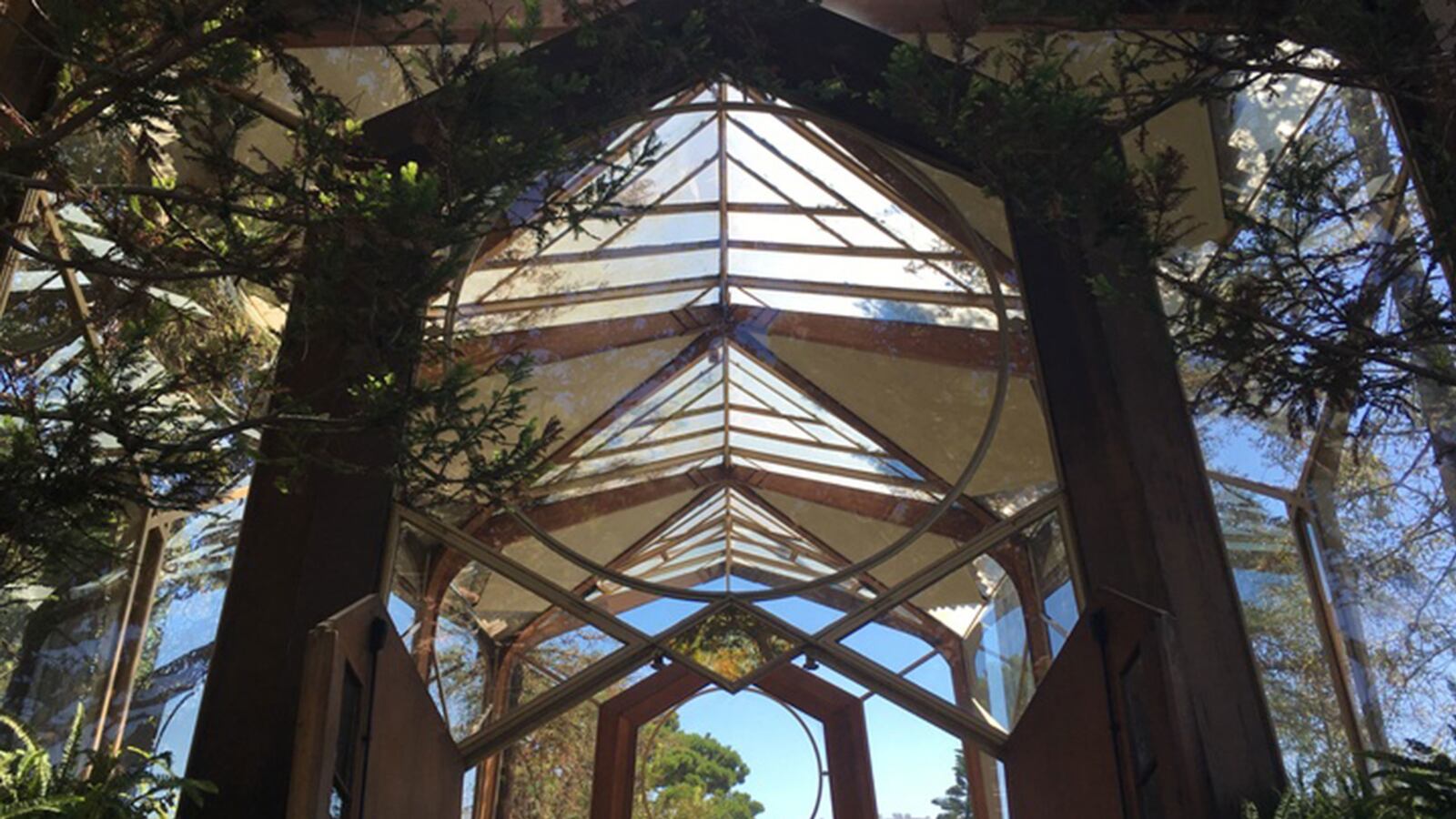PALOS VERDES — Just past the cruise ships and cranes of Terminal Island, the curving roads with ominous signs that warn of “constant land movement,” and Trump National Golf Course, a fairy tale escape like no other in the world sits perched atop a Rancho Palos Verdes bluff overlooking the Pacific: the Wayfarer’s Chapel.
Disney Land and the Chateau Marmont (as well as numerous tacky residential buildings throughout the region) provide Los Angeles with one type of fairy tale setting—that of the Châteauesque Sleeping Beauty type made famous by Ludwig II in Bavaria.
Designed by Frank Lloyd Wright Jr., the Wayfarer’s Chapel provides a different type of fairy tale setting—a magical sensation of being in a world of wood nymphs, lost unicorns, and other friendly fauna. Delicate triangular, trapezoidal, and circular skins of glass colored by the California sky and the sun filtering through surrounding trees are framed by parallel beams of redwood. The chapel’s vaulted glass ceilings reach only 28 feet high and it is just 27 feet wide, yet it envelops and overwhelms. Once described as being like “a soap bubble” for how the glass plays with light, the chapel sits atop a floor and foundation made of white local Palos Verdes stone. Outside, a variety of coastal redwoods, cypress, and pines create a sylvan, oceanside, spiritual oasis.
It all adds up once you learn that the chapel was designed for the American branch of the Swedenborg Church, whose eponymous founder believed that people are essentially spirits clothed with material bodies.
Dubbed by The New York Times as the world’s “forgotten man of genius,” Emanuel Swedenborg is one of history’s more impressive philosophers and is sadly not as well known as many of those Northern European intellectuals who would come after him. He would famously develop his own theological system of Christianity, and the church founded based on his writings would attract followers including Helen Keller, Johnny Appleseed, Daniel Burnam, and Robert Frost. Swedenborg’s writings would influence Oliver Wendell Holmes, Tennyson, Ralph Waldo Emerson, Mary Baker Eddy, William Blake, Honoré de Balzac, and, um, Dr. Oz.
Born in Stockholm in 1688 to a Lutheran bishop described as “thoroughly unpleasant,” Swedenborg spent the first half of his life as a prominent scientist. He entered the University of Uppsala at 11, achieved his Ph.D. at 21, and by his late twenties—by which time he was recognized as an authority on mining and metallurgy—he was appointed by the King of Sweden to oversee the country’s board of mines.
He was also an inventor, and like Leonardo da Vinci, he was prescient in the ways in which future inventors would solve flight or submarines or understand atoms. He also won a spot in the top echelon of individuals named by legendary psychologists Catherine Cox Miles and Lewis Terman (founder of the Stanford-Binet Intelligence scale) as the greatest geniuses before the turn of the 20th century. The list was made up of 300 people and included the likes of Jacques Necker, Ali Pasha of Janina, Goethe, and Lavoisier. Cox-Miles estimated that Swedenborg had a childhood IQ of at least 145.
In the late 1730s, Swedenborg’s focus shifted. He published The Economy of the Animal Kingdom, his first major attempt to bend science toward his ideas about the human soul. It investigated scientific understandings at the time about blood, organs, and the brain, but it also closed “most of the distances between the mining engineer and the mystic,” claimed Signe Toksvig in her biography of the philosopher. His work elaborated his belief that the soul could be found in the brain, and could be found in the cellular cortex. He believed the soul to be the inmost life of the blood and located in the brain.
In 1743 and 1744, the middle-aged Swedenborg had a Road-to-Damascus moment. He began to have visions and engaged in conversations with spirits. “It is precisely at this stage in Swedenborg’s extraordinary career that the skeptics take flight, and the believers gather around,” declared the historian C. Hartley Grattan. Some of these visits with the spirits were sexual in nature, and in one of them, he said, the Lord told him to abandon the sciences, which he did.
In 1771 Swedenborg published his seminal text, True Christian Religion, in which he tried to outline his understanding of the divine, scripture, eschatological issues, and the nature of man based on the author’s visions and communication with spirits. One year later, Swedenborg died, and though he never intended to found a church or a religious order, within a decade of his passing, Swedenborg societies and organizations devoted to his ideas had begun springing up.
Knowing full well that many pilgrims to the chapel by the sea are as likely to visit because it was featured in the O.C., the Swedenborg Church visitors center includes some handy explainers on the man’s philosophy.
One of Swedenborg’s teachings that has often attracted traditional Christians is that of the afterlife. As the handout notes, he believed, “People are essentially spirits clothed with material bodies. At death, the material body is laid aside and the person continues to live in the world of spirit choosing a heavenly life or a hellish one based on the quality of life choices made here.” A person’s religion does not affect that end result.
Those explainers are housed in the visitors’ center on site (built, it turns out, in 1998 after the original was torn down due to damage from a landslide. Of course, the new one was not built by Frank Lloyd Wright Jr.).
Frank Lloyd Wright Jr., who went by Lloyd Wright so as not to be confused with his illustrious father, was one of the most prominent architects in midcentury Los Angeles, whose significant legacy has been forgotten in large part due to his father’s fame.
But rarely does a work of architecture come as close to an architect’s theoretical intent as the Wayfarer’s Chapel. Wright was a practitioner of organic architecture, a philosophy that he told the Los Angeles Times “was an architecture that grows out of the site, the needs of the client, the nature of the materials, and a hope that it improves the surrounding area, and, generally, society.”
Before beginning the project in 1949, Wright visited redwood forests in Northern California and was moved. His design “sought to re-create the atmosphere of a redwood grove and create a sacred space that blended the natural and built environments.” Walking around the gardens, soaking in the filtered light through glass and wood, it is hard to escape romantic feelings about the synthesis of nature and architecture. It “prefigured the great glass religious structures to come more than 20 years later, such as Philip Johnson’s Crystal Cathedral and E. Fay Jones’s Thorncrown Chapel,” writes Nancy B. Solomon in Architecture: Celebrating the Past, Designing the Future.
Wright, in my opinion, has gotten the short end of the stick historically. Only one major book, as far as I can tell, has been written about his work. When he died in 1978 at 88 years old, the New York Times obituary read: “Lloyd Wright, Architect, Dies at 88; Was Son of Renowned Designer.”
One of Frank Lloyd Wright’s six children, Lloyd Wright was born in 1890 in Oak Park, Illinois. His career started early: he dropped out of the University of Wisconsin in 1909 and fled to Florence with his father and his father’s mistress Mamah Cheney. In 1911 he went to work for the legendary landscape architecture firm Olmsted and Olmsted, and by 1916 he was already the head of Paramount’s set design department. In the 1920’s he designed the first iteration of the Hollywood Bowl and also began to design buildings on his own. In 1927, using the stucco and concrete block style made famous by his father in Los Angeles, he built what would be his studio and home for the rest of his life.
Over the next few decades, Wright would build some of LA’s most iconic residences. His greatest hits include the Sowden House and Samuel Novarro House (recently restored by Diane Keaton and the center of a silent film era gay scandal) in Los Feliz, La Cañada in Gainsburg, the Mayan/Islamic Derby House in Glendale, the space-ship See-Worthy House in Palos Verdes, and the 676 square feet Mat House in Reseda. One of his houses designed and built in 1949 in Bel Air was bought by Elvis Presley and was the location for his meeting with the Beatles—but sadly it was destroyed.
Lloyd Wright never escaped his father’s shadow. His own son once told the Los Angeles Times, “there is no question about it that grandfather was a force, and though an inspiration to father, dominated his practice long after he died in 1959 and until father died in 1978.” His brother, John, who was also an architect, only managed to do so when he invented the Lincoln Logs.
But for the Wayfarer’s Chapel alone, Lloyd Wright should be in the pantheon of memorable American architects. Once built in the hopes that it would be used by weary travelers working their way down the coast, it is now used every day, often twice a day, for weddings. Several hundred couples a year choose the site to tie the knot—most of them from Japan.
In an era that was recently thrust into an even more uncertain direction, what could be greater than a work of art that ties together the genius of man and nature and inspires people to commit to a future together?






